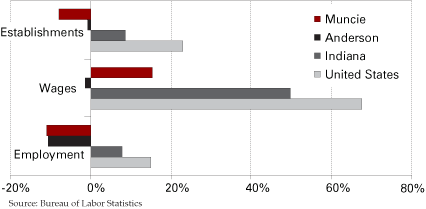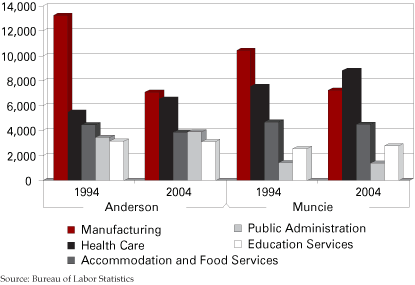Anderson and Muncie
Ball State University
As former Nixon economic advisor Herbert Stein once said, things that can’t go on forever usually don’t. That is the spirit in which we turn again to the task of projecting the economic future of the Anderson and Muncie metro for the coming year. Logic and reason say that the long, painful decline in these medium-sized cities, which began in earnest in the mid-1990s and continues to this day, cannot continue indefinitely. Yet the forecast of another down year in 2006 for each of these economies, in the light of current developments, continues to be the most reasonable forecast.
In the midst of an improving economic climate, particularly in the manufacturing sector, both the Anderson (Madison County) and Muncie (Delaware County) metropolitan areas continue to struggle just to tread water. Employment totals in 2005 thus far show no break in the pattern of decline that predated the recession, and the likelihood of more bad news for manufacturing facilities in Anderson (Delphi) and Muncie (New Venture Gear) digs the hole a little deeper for 2006.
Yet, there are success stories to be told in both communities. Considerable efforts are underway in both metro areas to attract and grow new business, as evidenced by the active small business incubators, innovative zoning initiatives, and other development efforts in each county. However, aggregate economic indicators continue to be dominated by the predominantly negative developments unfolding in the existing economic base.
Economic Performance to Date
Figure 1 shows the magnitude of the decline in Anderson and Muncie—similar to the declines in the nearby cities of Marion and Richmond. There were almost 8 percent fewer business establishments in the Muncie metro in 2004 than existed ten years earlier, with the number of employees on payrolls for the period declining by almost 13 percent. The Anderson metro suffered nearly an identical employment decline, although the number of businesses operating in the county remained nearly unchanged.
Figure 1
Business Growth, 1994 to 2004

Over the same period, 1994 to 2004, the national and the state economies posted respectable growth on both measures. Even though the state’s 8 percent growth in payrolls since 1994 is less than half the national average, it stands in stark contrast to the double-digit declines in the east-central part of the state.
These job declines have had a dramatic effect on wages, particularly in Anderson. Over a ten-year period that saw wage and employment propel total wages to a growth of nearly 70 percent nationally, wage earnings in Anderson actually registered a slight decline. That outcome reflects the high average pay of the jobs lost during these years. The loss of this base has been keenly felt by area merchants and other local businesses.
For both Anderson and Muncie, the employment base today has substantially fewer manufacturing jobs, as shown in Figure 2. Given the impacts of global trade and improving technology on manufacturing employment nationally, this is neither surprising nor new. What is of more concern is the relatively slow growth of the nonmanufacturing sector. Of the five industries with the largest payroll employment, only health care services has managed any significant growth since 1994. In the Muncie metro, more people work in health care than any other major industry.
Figure 2
Employment by Industry, 1994 and 2004

The Outlook for 2006
The recent trends in the external economic environment, particularly in the industrial economy, present both opportunities and threats to Anderson and Muncie in 2006. Certainly, the strength in business spending nationwide and the durability of the industrial expansion, which has propelled manufacturing output nationally beyond its pre-recession levels, present opportunities for many area companies. Yet special events in the automobile industry (in particular, the auto parts business) do not auger well, for Anderson especially.
The 500 jobs still at Delphi in Anderson are at considerable risk, given the GM spin-off’s bankruptcy filing and recent tough rhetoric on upcoming negotiations on wage and benefit reductions. Since 2000, the motor vehicle parts industry has shed almost a third of its workforce, and given the major losses at both Delphi and its biggest customer, General Motors, the survivability of the Anderson jobs is doubtful.
In Muncie, the announced closing of the former New Venture Gear transmission facility may be offset somewhat by the arrival of Magna Drive Train’s operations in the city’s southside industrial park. The rapidly changing nature of the parts industry, however, makes any sort of concrete projections for individual facilities very difficult.
Those impending events and recent trends in the data noted above suggest that the decline in the Anderson–Muncie employment base will continue into 2006. We project a job decline of 1 percent, or about 800 to 1,000 jobs, will be trimmed from the aggregate payrolls of the two cities in the next twelve months.
Also in this Issue…



